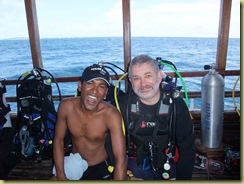Diving here is good. Because there are very few wrecks, most dives here seem to be Atoll based featuring one or more of walls, plateaus or ridge overhangs. The insides of house reefs are tame but usually have reasonable coral and fish.
Fish life varies from non existent to extraordinary, sharks are plentiful and Mantas and Whale Sharks exist at certain spots. There are few Lion Fish and other routine aquatic life hazards. Corals and sponges vary from average to astonishingly beautiful. There was never nothing to see.
Diving here can be challenging and often not for the beginner. It would be a brave (perhaps foolhardy) diver who attempts anything other than house reef dives without reasonable dive experience in their log book. In my opinion, the open ocean atoll dive spots are only suitable for experienced divers with at least 50 dives in their log book, some deep experience, good buoyancy control and the ability to cope with challenge. Negative entries were frequent. Enough fitness to cope with currents is essential and a Nitrox Certificate is invaluable (up to 30% was available on the Orion). On this trip, most 12 ltr divers soon switched to 15 ltr tanks because going close to dive limit boundaries was the norm and dive duration was often long. The majority of dives are on average deeper than those in the Red Sea, going below 25m for time up to the Deco mark is common (local laws forbid diving below 30m but this seems to be unofficially ignored). Dive profiles seem to show longer time at depth with relatively short ascent profiles.
Drifting at speeds varying from slow to very fast is common and can speed can change during a dive and often changes with depth. The direction of current flow often depends on the tide time and currents are usually stronger closer to a full moon. Visibility can vary from brilliant to poor and is affected by the speed of the current. It is not unusual to descend through clear water and see a layer with poor viz below you (or vice-versa).
Having the use of a decent reef hook is essential and many dives would have been impossible without one. Boats have them for divers to borrow but the one I purchased in the UK (coiled plastic covered wire with eyes - £12.50) seemed to be superior to the “hook on a string” type available on board.
Dive Computers and an SMB are essential as is the ability to use them. Open ocean pickup is common and hence surface confidence whilst waiting to be located is essential and this would be assisted if you had a surface flag. I found that a strobe flasher for night time surface use helped in my location and we all agreed that buddy pairs would benefit from having identical coloured lights or glow sticks on their cylinders at night to aid location underwater (choice of colours needed to avoid using the same colour as another pair).
The water was warm - my dive computer showed between 27 to 30c with little variation for time of day or depth. I dived in a Rashy and Trunks and never felt cold (late May), others in my group wore 3mm or shorties. The weather was hot and humid with heavy rain in the late afternoon (the cyclones change at this time of year producing this weather). Winds can make the sea choppy and surface visibility drops down to a few 10s of metres in the heavy rain.
Those that work out here say that if day diving, choosing a dive company which is at least Padi 5 star is essential since some dive companies have poorly maintained equipment and inexperienced guides – you get what you pay for and if it cheap you are buying what goes with cheap prices.
On a live aboard here, three dives a day is the norm because of the use of a Dhoni although I did not find this too much of a disappointment because the dives were often hard work. Night dives are usually interesting and the fish life becomes very interested in divers lights. I did 18 dives over 6 days and spent just over 14 hours underwater.
All dives were offered as guided and this was welcome. In general the dive guides knew the sites and ensured that although you were diving close to the limits, you did not exceed them.
I went out without a Buddy and was allocated one on the boat. On this particular occasion the arrangement did not work particularly well but other members of the group stepped in with support. Onboard allocation has worked well for me in the past and I am sure it will do so again in the future.
Any currency other than the local currency is accepted - $US being preferred. Dive boat tips were $100 per diver per week – on my boat this was divided equally between all members of the crew including guides.
My mobile phone seemed to pickup a signal in most of the places where I was (the middle section of the Maldives) hence texting was easy. Roaming and data charges are high. My boat rented Dongles to those desperate to stay in contact although weekly included data allowances were not high (400Mb).
One of our number produced a great trailer video which shows far better than my attempts, the beauty of the Manta Rays, the challenge of the currents and the great fish we met and it is well worth a play (I do feature in it but you would have to be able to recognise my fins):
I enjoyed my week on the Orion the dives with the Mantas were the most fantastic I have ever had and I hope to come back sometime to try again for Whale Sharks.
Thanks Dive Guide Moussa.


No comments:
Post a Comment